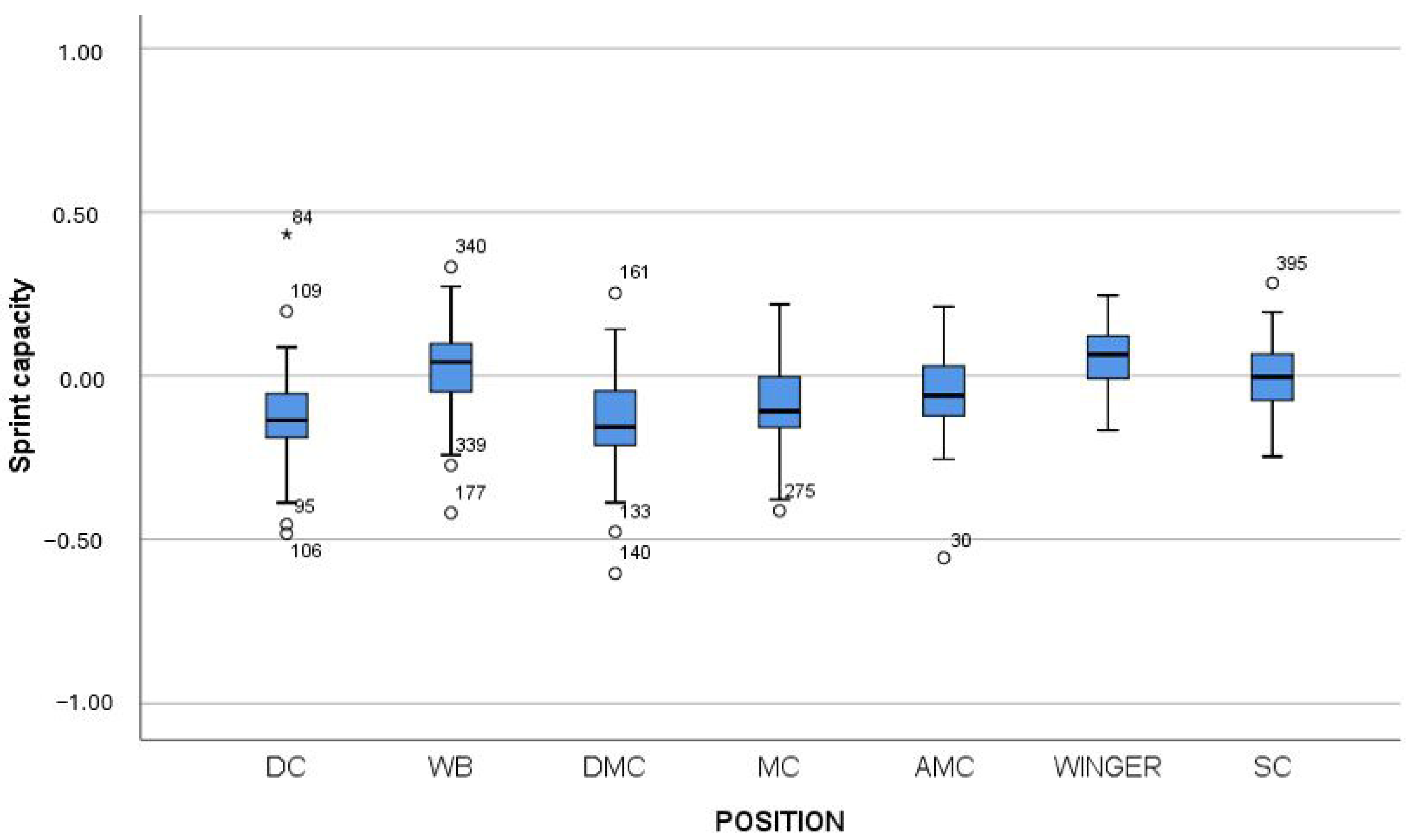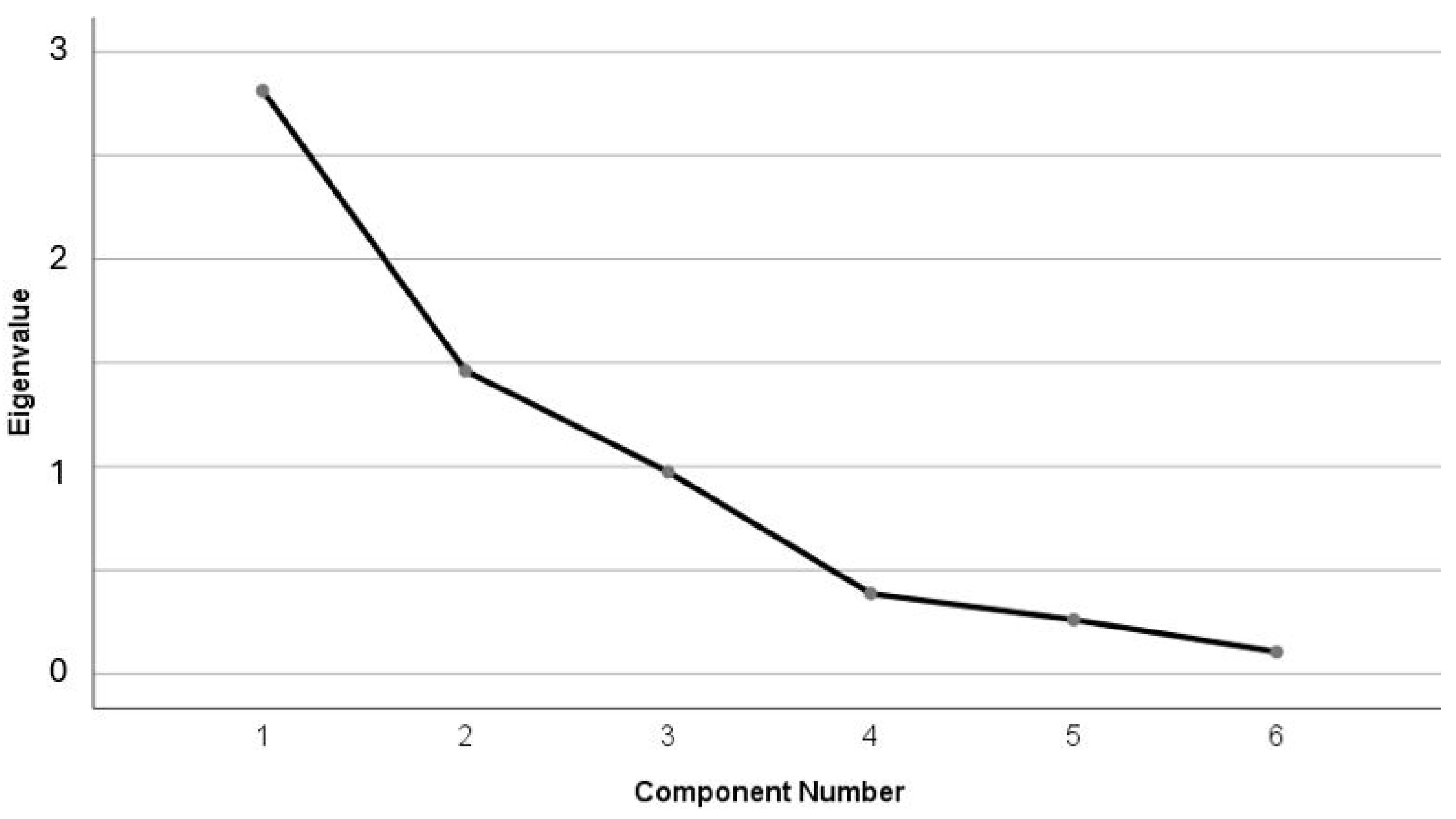1. Introduction
Soccer performance is influenced by a complex interplay of tactical, technical, psychological, and physical factors [
1,
2]. The physical demands of modern professional soccer involve greater work intensity and a more frequent competition schedule, requiring players to exert more effort than in past decades [
3,
4]. Furthermore, while the tactical, technical, and psychological demands are essential for determining match outcomes, the physical aspects not only contribute to performance but are also directly linked to player health, injury prevention, and support rehabilitation after injuries [
5,
6,
7]. For these reasons, the physical demands of the game warrant particular attention from practitioners, and consequently, academic interest in the physical performance of male professional soccer players during competition has grown considerably in recent decades [
8].
In recent years, considerable research has focused on the quantification of players’ external load during competitive matches through advanced tracking technologies [
2,
9,
10]. GPS (Global Positioning System) and optical tracking technologies can provide large amounts of data, offering numerous promising research opportunities and addressing the long-standing issue of small sample sizes, which are more susceptible to bias [
6,
11]. Typical indicators include total distance covered, distance covered at different speed thresholds, the number of accelerations and decelerations, the number of high-speed runs, and the maximal speed [
6,
10,
12]. Such metrics have been widely used to describe the physical demands of soccer players, but also to make comparisons between playing positions [
12,
13].
It has been widely accepted since the first time-motion analysis studies that there are significant differences in competitive physical activity profiles depending on the position, which are linked to the tactical demands specific to each role [
8]. As shown in the recent review by Sarmento et al. [
12] central and wide midfielders cover the greatest total distances during matches, averaging approximately 11,012 m and 10,894 m, respectively, with full backs also recording high values (10,457 m). In contrast, forwards (10,068 m) and central defenders (9598 m) cover considerably less ground. Regarding high-speed running, wide midfielders outperform all other positions, completing substantially more meters at high intensity (+106 m compared to full backs and +191 m compared to central midfielders). Central defenders and forwards show the lowest high-speed running values, while full-backs occupy an intermediate position, exceeding central defenders and forwards. Finally, in sprinting at maximum speed, wide midfielders again register the highest distances (330 m), followed by forwards (280 m) and full-backs (272 m). Central defenders record the lowest sprinting output (180 m), with central midfielders (224 m) also surpassing them.
However, all these studies, included in a review by Sarmento et al. [
12], have examined physical indicators in isolation, which may lead to fragmented conclusions. To date, no efforts have been made to identify the underlying components of physical performance in soccer through data-driven approaches such as factor analysis, although this is a common practice when analyzing technical–tactical variables [
14,
15]. A better understanding of how these variables group together into broader performance dimensions could provide deeper insights into physical match demands and contribute to more precise performance profiling across playing positions. This would greatly assist team coaches, analysts, and scouts in selecting the right players for the roster, as well as in determining the starting eleven.
Addressing this gap, the present study aimed to identify the latent components of physical performance in professional soccer players using match-derived external load data, obtained with the Instatscout optical tracking method. Furthermore, positional differences across the extracted components were examined to provide a deeper understanding of how different playing roles are characterized by distinct performance dimensions. We hypothesized that (a) a small number of meaningful components would emerge from the data, and (b) these components would differ significantly across playing positions. By doing so, this study seeks to advance knowledge on the structure of physical performance in soccer, thereby offering practical applications for performance analysis, training design, and injury prevention.
4. Discussion
The aim of this study was to identify the latent components of physical performance in professional soccer using match-derived external load data and to examine positional differences across these components. Three dimensions of physical performance (moderate-intensity running, high-intensity running, sprint capacity) were identified with significant differences across playing positions, confirming our initial hypotheses. More specifically, midfielders (DMC, MC, AMC) recorded the highest values in moderate-intensity runs, while the highest values of high-intensity running were identified in wingers and wing backs, and sprint capacity was associated mostly with the wingers. The novelty of these findings comes from the examination of the latent structure of physical performance during match play, rather than the isolated analysis of a commonly used set of external load indicators. Identification of these components and the variability in them between the various positions contributes to a more integrative understanding of the physical demands of soccer for player profiling, position-specific training, and injury prevention strategies.
Although no previous research has identified the components of physical performance as such, when considering the variables that load on each factor, our findings are consistent with earlier studies. In particular, we found that wide players (wingers and WBs) reached higher maximal speeds compared to players in other positions, a result also reported in previous research [
32,
33]. This can be explained tactically by the fact that wide players frequently operate in situations where they can exploit available space. Unlike central players, who often act in congested zones with limited room and heavy defensive pressure, wide players more often have the opportunity to run through open corridors (flanks) with greater distance ahead of them [
12]. Especially during transitions, wingers and WBs are required to cover long stretches of the pitch at maximal speed, either to support attacking actions or to recover defensively [
34,
35]. This reflects the demands of modern soccer, where coaches expect WBs not to remain solely in defense but to advance and provide attacking width when the team is in possession. Conversely, wingers are often required to track back and support defensively, either by doubling up against the opposing winger or by covering the weak side when the ball is played to the opposite flank and the WB tucks inside to maintain compact distances within the defensive line.
The ability of wide players to exploit large spaces and corridors explains why these players also cover the greatest distances at high-speed intensities (>5.5 m/s). This finding is consistent with previous research. For example, Ingebrigtsen et al. [
36] reported that players in lateral positions covered significantly greater high-speed distances compared to central players, both in each half separately and across the full match duration. Moreover, this pattern appears to be consistent across different populations, as has also been confirmed in studies on female players [
37]. In addition, numerous studies have demonstrated that midfielders (both central and wide) are the players who accumulate the greatest total distance during matches [
38,
39,
40]. Given that wide midfielders also cover larger distances at high speeds, it is reasonable that, within the factor Moderate-speed running distance, the different types of central midfielders (DMC, MC, AMC) emerged with the highest values. This outcome reflects their pivotal role in match play, as central midfielders typically occupy positions of high centrality in network analyses, constantly linking defensive and offensive actions and thereby requiring sustained moderate-intensity running across all phases of the game [
35,
41].
Furthermore, these positional differences are also influenced by the distinct physiological adaptations and typical training emphases associated with each playing role. Wide players are frequently involved in training and match scenarios that require repeated high-speed runs and sprints along wide corridors, which enhance their ability to sustain high-intensity efforts. In contrast, central midfielders regularly engage in activities that involve continuous movement and mixed-intensity efforts, reflecting their role as links between defense and attack. Over time, these positional demands contribute to differences in aerobic capacity, running economy, and anaerobic speed reserve, which are reflected in the observed physical performance profiles [
42,
43,
44,
45,
46].
A major strength of the present study is its data-driven approach to identifying and interpreting the latent components of match-derived physical performance. Contrary to previous studies on this subject that used and interpreted single indicators (e.g., total distance, number of sprints, distances covered at various intensity levels), the present study provides a framework for combining match-derived variables into meaningful dimensions. It is worth noting that Oliva-Lozano et al. [
47] also identified three components but focused on constructing a composite index and did not examine positional differences for the individual components. Furthermore, we analyzed variability across seven distinct outfield playing positions, whereas their positional classification was limited to only three broad categories (defenders, midfielders, forwards), which likely contributed to the small effect sizes they observed. This contribution fills a critical gap in the international literature, offering a novel conceptualization of soccer’s physical demands. Beyond its academic value, the findings carry important practical implications. Scouts, coaches, and performance analysts can use these components to better understand the positional requirements of modern soccer, thereby improving talent identification and roster composition. Moreover, the results provide benchmarks for rehabilitation and return-to-play processes, helping practitioners determine the physical capacities players must regain after injury according to their playing position.
Despite these strengths, the present study also has certain limitations that should be acknowledged. First, the dataset was derived from a single league (Turkish first division), which may limit the generalizability of the findings to other competitions with different tactical and physical demands. Second, only external load indicators were analyzed, while no internal load or physiological measures (e.g., heart rate, lactate, RPE) were included, which could have provided a more comprehensive picture of players’ physical performance [
48,
49,
50]. Third, the data for the players’ position (e.g., WB, DC, SC, etc.) refer to the main position in which they play; however, this does not mean that their coaches did not use them in a different position in some games (or part of them). Fourth, contextual variables such as tactical formation, playing style, match status, opponent quality, and environmental conditions were not considered, although they are known to influence physical outputs [
18,
51,
52,
53,
54]. Finally, the cross-sectional nature of the analysis does not account for within-player variability across a season or potential longitudinal adaptations. Future research should therefore aim to replicate these findings in other leagues and competitive levels, integrate more external load variables (e.g., accelerations and decelerations) and internal load measures, and adopt longitudinal designs to capture changes in physical performance components over time.
5. Conclusions
This study revealed three key components of physical performance in professional soccer (moderate-intensity running, high-intensity running, and sprint capacity), each showing clear differences across playing positions. Central midfielders were characterized by sustained moderate-intensity activity, wingers and wing backs stood out for their high-intensity running, and sprint capacity was most evident among wingers. By moving beyond single variables and instead identifying broader dimensions of performance, this work offers a more integrated understanding of the physical demands of modern soccer.
From a practical perspective, these findings provide useful information for coaches, analysts, and scouts when designing training programs, profiling players, or planning rehabilitation targets after injury. At the same time, the study highlights the importance of tailoring physical preparation to the unique requirements of each position. Future research should build on this framework by including data from different leagues and competitive levels, integrating internal load measures, and tracking changes over time. In doing so, we can move closer to a holistic view of physical performance in soccer that connects research insights with applied practice on the field.














